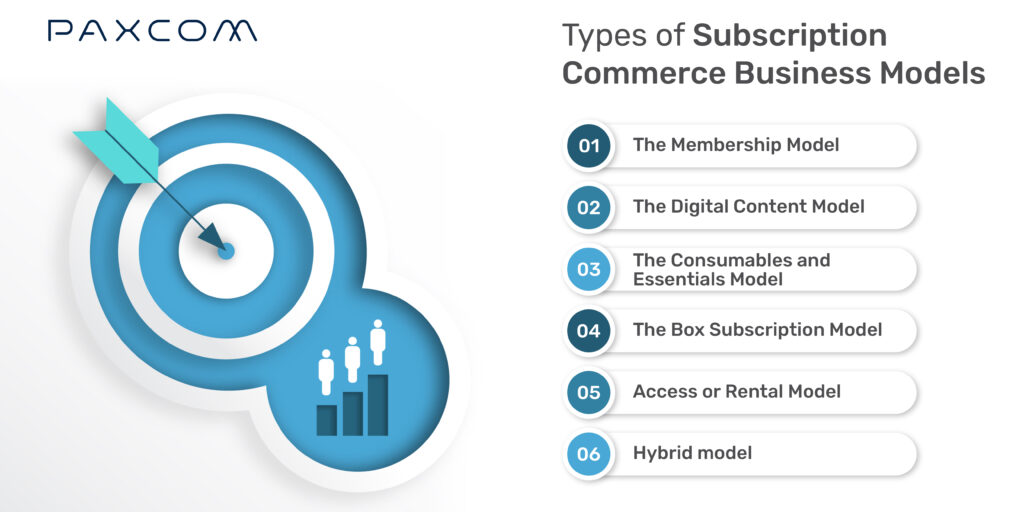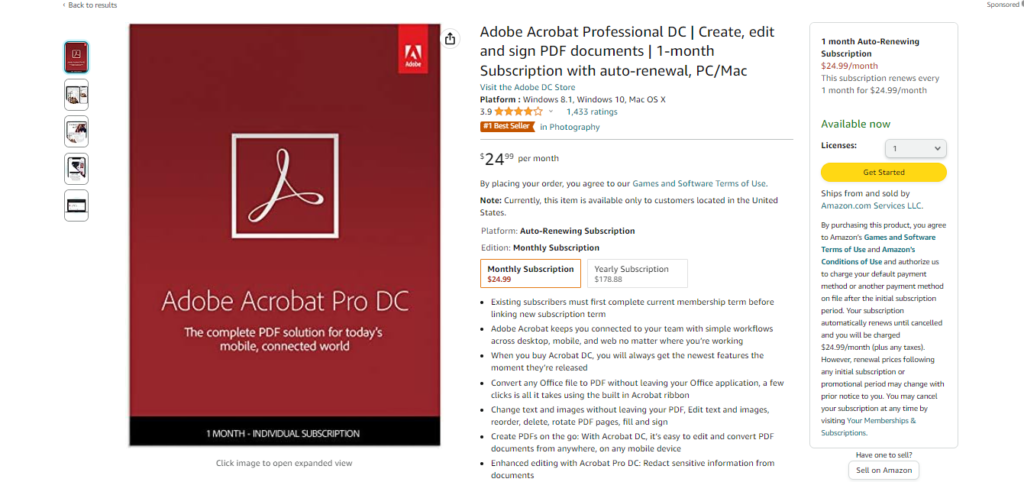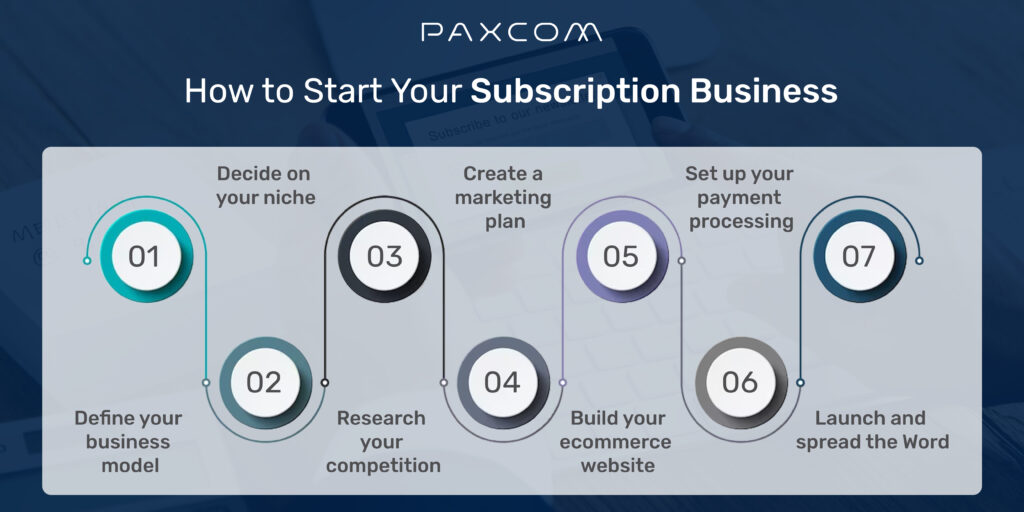In 2022, the global e-commerce market for subscriptions was worth $96.61 billion. By 2028, it is anticipated that the market value will increase to $2,419,69 billion, and in the USA, by 2023, subscription e-commerce is expected to generate over 38 billion dollars in revenue.
Subscription e-commerce has become a popular way of purchasing goods and services online. This model allows customers to sign up for subscriptions and receive the products or services regularly. It’s a convenient way to ensure you never run out of your favorite products and can save you time and money in the long run. With subscription e-commerce, you can easily manage your orders and deliveries and enjoy the convenience of having your favorite products delivered right to your doorstep.
These boxes are typically delivered monthly or weekly, depending on the customer’s chosen subscription plan.
Table of Contents
Types of Subscription Commerce Business Models

The Box Subscription Model– This business strategy entails providing monthly shipments of a compiled assortment of goods to customers who have subscribed to the service. Some examples of subscription boxes include those for fashion, food, cosmetic products, and even pet supplies. Customers are often required to pay a fixed price in order to get a box containing products on a regular monthly or quarterly basis.

The Membership Model– This model requires users to pay a monthly/annual subscription to access various exclusive material, bonuses, and discounts. This may involve access to a private community, early access to product releases, exclusive material, or individualized service offerings.
The Digital Content Model- is centered on delivering digital content to subscribers, including e-books, online courses, music, or video streaming services. Users are charged a recurring fee for unrestricted entry to the digital content collection or specific functions.
The Software as a Service (SaaS) model involves the provision of software applications by companies on a subscription basis. This allows customers to access and utilize the software for a specified duration. Customers usually make regular payments determined by various factors such as usage, features, or the number of users.

The Consumables and Essentials Model– This model is based on the concept of routinely providing consumable or necessary items to consumers who have a frequent need to buy such products. These services include coffee, razors, vitamins, or cleaning product subscriptions.
Access or Rental Model– This model allows members to either gain access to high-value assets or rent items for a predetermined amount of time. Examples include renting cars on a subscription basis, having access to shared office spaces, or having access to excellent tools and equipment.
Hybrid model– where customers are charged a monthly fee for access to a service but are also charged for the service or product when they use it. This is common with online courses, where customers are charged a monthly fee for access to the course content but are also charged for any add-ons or extras they use.
It is crucial to identify a model that is in line with the target market and the features of the products or services being provided.
How to Start Your Subscription Business
1. Define your business model
When it comes to subscription commerce, companies use a few different business models to make money. The most common business model is a monthly recurring revenue model, where customers are charged a monthly fee for access to a service or product. This could be anything from a streaming service like Netflix, to a software service like Adobe Creative Cloud, to a physical product like a Birchbox subscription.
Another standard business model is a pay-as-you-go model, where customers are only charged for the service or product when they use it. This is common with cloud-based software services, where customers only pay for the storage and computing power they use. It’s also shared with physical product subscription boxes, where customers are only charged for the products they receive (and not for the shipping).
Which business model you choose will depend on several factors, including what you’re selling, your target market, and your overall business goals. But whichever model you choose, subscription commerce can be a great way to build a sustainable and recurring revenue stream for your business.
2. Decide on your niche
As a business owner, one of your first decisions is choosing your niche. This can be a difficult task, as there are endless possibilities and no one-size-fits-all answer. However, there are a few key factors to consider that will help you zero in on the right niche for your business.
The first factor to consider is your target market. Who are you trying to reach with your business? What needs does your target market have that you can fill? What are their buying habits? Knowing your target market is essential for choosing a niche that will be profitable.
The second factor to consider is your competition. Who else is selling products or services similar to what you’re offering? What are they doing well? What could you do better? Choosing a niche where you can differentiate yourself from your competition is essential.
Once you’ve considered these factors, it’s time to start brainstorming niche ideas. Write down a list of potential niches and then narrow it down to your top three. From there, you can start researching each one in more detail to see if it fits your business correctly.
Deciding on your niche is an important decision for any business owner. By taking the time to consider your passion, target market, and competition, you can choose a niche that will set your business up for success.
3. Research your competition
As a subscription commerce company, staying ahead of the competition is important. To do this, you need to research your competition. Here are three tips to help you analyze your competition:
- Know your market
The first step to research your competition is to know your market. What are the demographics of your target audience? What needs does your target audience have that need to be met by your competition? Knowing your market will help you better understand your competition and how to position yourself in the market.
- Know your competition
The second step to research your competition is to know who your competition is. What are they offering? What are their strengths and weaknesses? How are they positioned in the market? Knowing your competition will help you better understand your position in the market and how to compete against them.
- Know your strengths and weaknesses.
The third step to research your competition is to know your strengths and weaknesses. What can you offer that your competition can’t? What are your weaknesses, and how can you overcome them? Knowing your own strengths and weaknesses will help you better understand how to position yourself in the market and how to compete against your competition.
4. Create a marketing plan
As the subscription commerce industry continues to grow, businesses need a solid marketing plan. There are a few key things to keep in mind when creating a marketing plan for a subscription business.
- Understand your target market.
Who are your potential customers? What are their needs and wants? What motivates them to make a purchase? Answering these questions will help you create targeted marketing campaigns that speak directly to your target market.
- Define your brand.
Your brand is more than just your logo or tagline. It’s the feeling potential customers get when interacting with your business. Defining your brand will help you create consistent marketing materials that reflect your company’s values and mission.
- Set marketing goals.
Focus on these questions before defining your marketing objectives: What are the goals you want to achieve of the campaigns you’re running? Want to boost brand exposure, website traffic, or sales? Set defined, measurable goals to track your progress and alter your marketing plan as needed.
- Choose the right marketing channels.
Various marketing channels are available, from traditional advertising to digital marketing. Choosing the channels that will reach your target market and help you achieve your marketing goals is important.
- Create compelling content.
Your marketing campaigns should include compelling content that captures attention and drives engagement. Whether it’s a blog post, an infographic, or a video, your content should be interesting and informative.
- Track your results.
Finally, tracking your results is vital to see what’s working and what’s not. Monitor your website traffic, sales, and other key metrics to see how your marketing campaigns perform.
Following these tips, you can create a solid marketing plan to help you achieve your subscription commerce goals.
5. Build your ecommerce website
Create an online presence by developing a professional and user-friendly website. This website should showcase your subscription offerings. Please ensure that the product/service descriptions are detailed, pricing information is clearly stated, frequently asked questions are addressed, and an intuitive subscription management system is provided. Investing in high-quality product images and compelling copy is recommended to attract potential subscribers.
6. Set up your payment processing
Choose a trusted and safe payment gateway to manage subscription payments. Integrate a system for managing subscriptions that enable customers to quickly sign up, modify their subscriptions, and administer their accounts. Consider providing flexible invoicing options, such as monthly, quarterly, and annual cycles.
7. Launch and spread the Word
Now that your business is running, it’s time to start spreading the word. Use your marketing materials to get the word out. Tell your friends, family, and social media followers about your business. And remember to ask for referrals!
Conclusion
The subscription commerce industry in the U.S. is experiencing a rapid increase in size and offers enormous business opportunities. Subscription e-commerce is proving to be a lucrative business model, with a projected market value of over $38 billion by 2023. By strategically navigating the market, understanding customer preferences, and implementing effective marketing and operational strategies, businesses can establish a strong foundation and thrive in this dynamic environment. Connect with us today and take your first step towards subscription commerce in the USA.















